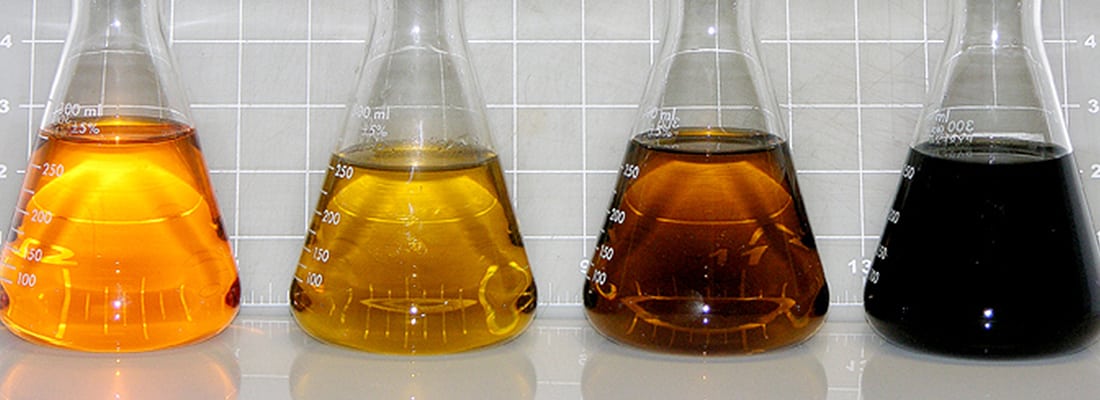If you’ve ever wondered what particle count is and what it’s used for, you’re not alone. While a common test, not all maintenance managers are aware of how the test works or how it helps them improve their reliability.
Why we test
The reason why we test particle count is because some particles in the oil can cause damage to the machine, particularly hydraulic equipment. Particles can cause scratching of the machined surfaces and, as a result, cause more wear. The damage compounds until you have major failures.
How it works
When we conduct the particle count test, we pass oil through a light obscuration sensor with a laser. As particles move over the sensor, the size of the shadow is measured and the number of each size category of particles is counted. We can then gather a list of the number of particles at each size category and determine the level of contamination in the oil.
The size categories we measure are:
- 4 µm
- 6 µm
- 10 µm
- 14 µm
- 21 µm
- 38 µm
- 70 µm
- 100 µm
We report our findings using a codifying system (ISO 4406) which converts the counts for 4 µm, 6 µm and 14 µm into a number series that is then used to report and compare, normally referred to as the ISO code. For example, results of 18/15/11 mean that, there were 2,500 – 5,000 particles at 4 µm or greater, 320 – 640 particles at 6 µm or greater, and 20 – 40 particles at 14 µm or greater.
Particle size and the effect on equipment
In general, lower ISO code numbers overall are more desirable, potentially having less impact upon machinery, though size and filter rating may mitigate that.
All things being equal, larger particles have a greater chance of spanning the oil film diameter between two metal surfaces and damage one or both of them. As the surface is damaged, more particles are created, resulting in a snowball effect leading to potential critical failures of the system.
However, the sample could have been collected after the source of the particles and before they are collected in the fluid filter. In this case, the smaller numbers could be more important because they cause pitting or sliding wear at other points in the system.
Filtering out small particles poses its own problem. They are more difficult to capture than larger particles and require specialized filters to collect.
DID YOU KNOW?
The number series used by the ISO cleanliness code is called a “Renard series” or “preferred numbers” in general. Charles Renard originated the system while serving as a French army engineer colonel during the 1870’s. Originally, it was used to reduce the different type of ropes used by balloon airships from 425 to 17.
“Soft” and “Hard” Particles
Most laser particle counters count the particles via light obscuration. In essence, they detect the shadow of the particle as it travels across the laser light. The limitation of this technology is that it does not differentiate between “soft” and “hard” particles.
Hard particles are the particles that cause the damage to a machine. These include pieces of dirt, steel and other wear metals that can contaminate the oil.
Soft particles are not harmful in the same way as hard particles. They typically fall into three categories: water, additives and varnish/sludges. Fine water droplets are counted as particles by this technology and, to make matters worse, they can be a variety of sizes depending on the dispersion of the water in the sample. Other oil analysis tests are used to specifically measure the total amount of water present in the oil, not just the dispersed water.
Some oil additives are detected as small particles. For example anti-foam additive is designed to be a small particle, helps the foam break quickly, and does not damage equipment, yet is detected by most particle counters
The last example of soft particles are varnishes and sludge. Both of these can potentially count as particles, however, they will not usually cause particulate damage to the machine. They do cause other issues but not in regards to particulates, and other tests do a better job of detecting when the amount of sludge and varnish is harmful.
New particle count technology
Our team adopted the new particle count technology (CiNRG) which uses a Toluene and Propan-2-ol mixture as a diluting solvent. The Toluene component will dissolve any additives, varnishes and sludges so that they don’t count as particles. The Propan-2-ol (a.k.a Isopropanol) dissolves water so that it doesn’t count as a particle. This may return slightly lower amounts of particles, but it takes the guesswork out of the testing and ensures the results represent what the test is searching for – the volume of particles that could damage equipment surfaces.
Varnishes, sludges and water are harmful to machines. However, each of these items can and should be, detected by other testing, such as FT-IR, ICP and Karl Fisher.
If you are interested in learning more about particle count testing, contact our team.

Proven Impact. Proven Uptime. Proven Savings.
Let us prove it to you.




